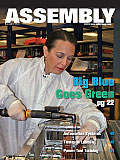
Many manufacturers talk about being green. But, when it comes to action, few companies can matchInternational Business Machines Corp.(IBM, Armonk, NY). Big Blue has focused its efforts on sustainability.
That environmental commitment is evident on the assembly line at IBM’s Poughkeepsie, NY, plant. The 315,000-square-foot facility assembles high-end computer servers, which were traditionally called mainframes. When the Internet first became popular a decade ago, IBM rebranded mainframes with its enterprise-server marketing campaign.
The plant, situated on a wooded 500-acre campus along the banks of the Hudson River, is committed to the environment through a Green Sigma initiative. The goal is to save money, boost productivity and reduce the environmental impact of IBM’s end-to-end supply chain operations through more efficient management of energy, materials and natural resources, and minimize waste and emissions.
Disassembly and remanufacturing play a pivotal role in the day-to-day operations of the 67-year-old Poughkeepsie plant. During the last five years, the plant has reused more than 11 million parts. More than 1,450 high-end systems have been recovered, refurbished and reused, while more than 25,000 metric tons of metal have been recycled. In fact, less than 2 percent of total material went to landfills.
“At IBM, we see conserving energy and preserving the environment as a strategic business opportunity,” says Jim King, plant manager. “We’re actively in pursuit of accurately characterizing the carbon footprint of our manufacturing processes. That’s mostly accomplished by metering our manufacturing processes, as well as building energy dashboards and integrating energy into simulation modeling exercises.
“We’re also partnering with our real estate teams to recognize savings with lighting options, temperature and humidity specifications, and other green techniques,” adds King. “In addition, we’re examining inbound logistics for opportunities to recycle packaging. We also reuse packaging on outbound logistics, which we recover from the field for domestic reuse.”
The plant is currently implementing a major recycling initiative and conducting a full waste audit that encompasses materials such as bubble wrap, electrostatic discharge (ESD) bags, foam inserts and shrink wrap, in addition to traditional forms of paper and plastic. Employees are encouraged to participate in “lunch and learn” sessions where they discuss various green initiatives.
The ISO 14001 and ISO 9001:2000 certified facility is also a leader when it comes to lean manufacturing activities. By optimizing production processes through lean techniques such as 5S, kaizen and visual systems, King and his advanced manufacturing sciences team have saved IBM more than $7 million over the last two years.
Because of those lean and green efforts, the Poughkeepsie facility is the recipient of ASSEMBLY magazine’s fifth annual Assembly Plant of the Year award. The plant has also achieved impressive results addressing the unique challenges of high-mix, low-volume assembly, such as supply chain management.
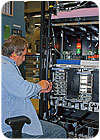
Complex Products
The 2008 Assembly Plant of the Year is responsible for developing and manufacturing the world’s most complex enterprise servers, which are used extensively for applications in science, industry, government and academia.
Products such as System z and Power Systems are used by companies around the world to maintain and process vast amounts of data. Many of those high-end servers are located in the back offices of airlines, banks, brokerage firms, car rental companies, casinos, credit card issuers, government agencies, hospitals, hotel chains, insurance companies, retailers, universities and research laboratories.
During the last five decades, the Poughkeepsie plant has built thousands of mainframes and servers. Many of them rank among the fastest and most powerful computers in the world. Earlier this year, the plant made history when it assembled the world’s fastest computer for the National Nuclear Security Administration’s Los Alamos National Laboratory (Los Alamos, NM).
The Roadrunner supercomputer was the first system in the world to break a milestone known as a petaflop-the ability to calculate 1 quadrillion operations every second. The computer packs the power of 100,000 laptops-a stack 1.5 miles high-and is more than three times faster than the nearest non-IBM computer.
Assemblers in Poughkeepsie also built the second- and third-fastest supercomputers in the world, which are housed at Lawrence Livermore National Laboratory (Livermore, CA) and Argonne National Laboratory (Argonne, IL), respectively. During last summer’s Olympic Games in Beijing, China, the local weather bureau used a Poughkeepsie-built IBM System p575 to aid in weather forecasting and air-quality control. And, the IBM Deep Blue machine that beat world-champion Gary Kasparov in a highly publicized chess match back in 1997 was manufactured in Poughkeepsie.
Earlier this year, IBM introduced three new products that are assembled in the plant:
-
The System z10 mainframe was designed from the ground up to dramatically increase data center efficiency by significantly improving performance, while reducing power, cooling costs and floor space requirements. It is up to 50 percent faster than its predecessor, the z9, and offers up to 70 percent more capacity.
-
The Power 575 supercomputer helps end users tackle some of the world’s most challenging problems in fields such as aerospace, energy and weather modeling. It uses a unique copper-plumbed water-cooling system and is equipped with IBM’s POWER6 chip, the world’s fastest microprocessor. The Hydro-Cluster offers nearly five times the performance and more than three times the energy efficiency of its predecessor.
- The Power 595 UNIX enterprise server is designed to simplify data center infrastructure and reduce operating costs through server consolidation, easier systems management and energy savings. It ranks as the world’s fastest UNIX system. Unlike the Power 575, this machine is air-cooled using traditional fans.
“The marketplace has been very receptive to these products,” says King, who has been with IBM for more than 20 years. As a result, his plant is booming with activity. It currently operates three shifts a day, seven days a week. To keep up with the demand generated by the new products, the plant has recently hired additional assemblers.
More than 6,000 people work on the Poughkeepsie campus to develop and manufacture high-end servers. In addition to the 700 people who work in the factory, the site includes numerous R&D labs, engineering offices and customer support centers.
Manufacturing is colocated with hardware development labs. “This is important, because we’re able to act as one team-development, manufacturing and engineering-in terms of bringing new products to market at the frequency required to compete and lead in this market segment,” says Warren Boldrin, manager of advanced manufacturing sciences.
“We are responsible for a significant portion of the hardware in IBM’s portfolio, and this serves as an important aspect of the complete IBM solution,” claims Boldrin. “Servers range from several hundreds of thousands of dollars to millions of dollars per order. As such, each order has the potential to represent a substantial impact on the company’s financial performance. Given the revenue implications associated with each and every order, this plant operates with complete focus on having an order shipped on-time with superior quality, at a cost which represents value to our customers.”
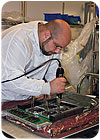
Customer-Driven Assembly
The Poughkeepsie plant currently builds four major types of machines and 25 basic models. Each unit is about the same size as two coin-operated soda machines placed side-by-side. The relatively unassuming black boxes measure approximately 72 inches tall, 40 inches deep and 36 inches wide.But, no two machines on the assembly line are exactly alike, due to customer specifications. Every machine is custom-built and crammed full of powerful microprocessors, memory cards and other electronic components based on unique specifications ordered by customers.
There are approximately 5,000 bill-of-material structures that reflect various options on the configured machines. “These options further decompose into thousands of part numbers,” explains King. “The complexity comes with the fact that there are an infinite amount of permutations associated with each of the feature codes. Each machine we ship out of Poughkeepsie is built to exact customer specifications, reflecting a unique DNA. If you were to explode each of the bills of materials, it would [reveal] literally hundreds of thousands of discrete components.”
Despite the complexity of the product, the simplicity of the production process allows the plant to excel. “The assembly team takes great pride in meeting customer expectations,” says King. “We base our efforts and discussions on business value and customer focus. And, all improvements are driven by one or more of our business values: cycle time, quality, culture, inventory and cost.”
The Poughkeepsie plant also includes a large panel assembly and test (LPAT) operation, which represents the heart of the technology used in IBM’s high-end server offerings. These operations take raw components, such as transistors and resistors, along with the IBM Multilayer Ceramic Module, and populate them onto highly complex printed circuit boards using high-speed placement tools. The panels then proceed through compliant pin and pin-hole inspections, including X-ray processes, and then they are subsequently tested. Most of the chips are made 10 miles away at IBM’s state-of-the-art 300-millimeter semiconductor plant in Fishkill, NY.
The LPAT operation is strategically located in a separate building near the box-line factory. “IBM’s ownership of these critical up-stream processes is a huge competitive advantage in terms of consistently refreshing the performance offerings at the traditional three-year cycle,” says Jeff Boniello, LPAT fabrication test manager.
Many LPAT subassemblies are also shipped from Poughkeepsie to IBM facilities overseas. “We act not only locally, but we operate as a member of the globally integrated enterprise in several ways,” Boniello points out. “All the new products for high-end servers are launched from here. Poughkeepsie is a single worldwide source for some of the most sophisticated subassembly technology available in the marketplace.” The plant supplies IBM order fulfillment centers in Brazil, France and Ireland.
“We have the capability to balance orders between plants, as well as redistribute inventory based on where the demand is worldwide through interplant transactions,” explains Boniello. “The plants IBM maintains across the globe not only give us a presence in other geographies from a marketing standpoint, but we’re also able to favorably optimize business operations, as well as reduce distribution costs associated with large orders.”
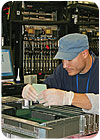
New Challenges and Opportunities
The Poughkeepsie plant has been the heart ofIBM manufacturingsince the early 1940s, when the company took over a former pickle factory located in a rural area 70 miles north of New York City and began making munitions and other items to support the war effort. In 1948, IBM built a new plant nearby and started mass-producing electric typewriters. Data processing products, such as key punches and sorters, were added to the production mix a few years later.The IBM 701, the company’s first mass-produced electronic computer, was assembled in Poughkeepsie starting in 1952. As the decade progressed, the 700-series of vacuum-tube machines helped spur corporate America’s transition from punched-card machines to electronic computers. In the late 1950s, IBM engineers built the world’s first fully automatic production line for transistors in Poughkeepsie. It produced and tested 1,800 individual transistors an hour.
Assemblers in Poughkeepsie began building the revolutionary System/360 mainframe in 1964. It was the first large “family” of computers to use interchangeable software and peripheral equipment. A company could start with a small computer and plug in others as its needs grew without having to buy new software. The popular System/360 also played an important behind-the-scenes role in the U.S. space program by monitoring and guiding Apollo flights at mission control in Houston.
Despite all of that success and proud heritage, IBM hit a rough patch in the early 1990s after weathering a decade of change wrought by the PC revolution that it helped usher in. But, the company successfully transformed itself by focusing on integrated solutions and enterprise IT architectures that support network computing.
Today, IBM has three major business segments: hardware, software and business services. Although many companies in the computer industry have outsourced hardware production, IBM still chooses to build its high-end servers in-house as a strategic business initiative that helps it maintain a competitive advantage in the marketplace.
“IBM Corp. views System z and Power Systems product offerings as critical because our marketing strategy centers around a complete solution offering for our clients,” says King. “IBM maintains a competitive advantage in that we can deliver products and services selected from any one of these elements which translate into tremendous value to our customers.
“Without System z or Power Systems, [we would not] have the presence in the market we enjoy today,” adds King. “The high-end server line remains as the cornerstone of the hardware offerings because of both revenue and margin contribution to the corporation.
“Our products provide the IT backbone of many industries, which depend on IBM to run the lifeblood of their respective missions,” King points out. “Without System z and Power Systems offerings, IBM would not be as favorably positioned to capitalize on software or consulting services.”
As a result, IBM continues to invest heavily in the Poughkeepsie site. For instance, during the past year, the factory was retooled and redesigned to optimize line flow.
“We have demonstrated time and time again that our execution is world-class from both a serviceability and quality perspective,” explains Boldrin. “This directly aligns to our market-driven, customer-centric values.
“The Poughkeepsie team is proud that IBM Corp. places its trust and confidence in our hands to deliver a customer experience that exceeds expectations,” notes Boldrin. “One of our foundational corporate values at IBM is ‘dedication to every client’s success.’ We take that very seriously in terms of the role Poughkeepsie maintains to ensure our customers recognize and capitalize on the relationships and investments they make with IBM.”
The products made at the 2008 Assembly Plant of the Year typically end up in data centers-secure backroom facilities that are filled with banks of computers that process high-volume transactions such as credit card purchases and drivers license forms. Data centers form the backbone of the world’s IT infrastructure. However, many of them are undergoing a dramatic transformation, which is increasing demand for IBM’s new products, such as the System z10.
According to a recent study conducted by Gartner Inc. (Stamford, CT), a research and consulting firm, more than 70 percent of large corporations will have to modify their data centers during the next five years. Businesses are working to not only greatly reduce the inefficiency and complexity of their data centers, but also to share IT resources more efficiently and better align them to ever-changing business conditions.
Exploding demand for digital transactions enabled by the Internet is also creating crowded, overburdened corporate data centers. Many facilities have become highly distributed and somewhat fragmented. As a result, they are limited in their ability to change quickly and support the integration of new types of technologies and transactions.
In addition, many companies are attempting to boost their operating efficiency by reducing computer power, cooling costs and floor space requirements. Approximately 87 percent of today’s data centers were built before 2001, when cheap power and falling hardware costs permitted IT organizations to increase productivity while ignoring energy resources.
Energy costs associated with running data centers, based on million instructions per second (MIPS), are expected to rise from less than 10 percent to 30 percent of IT budgets in the coming years. “That’s why the System z10 features an 85 percent smaller footprint and up to 85 percent lower energy costs than its predecessor,” says Robert Edge Jr., systems engineering manager.
“Advances in IBM high-end server technology have drastically reduced the physical footprint of the frame,” says Edge. “In the 1960s, it would have taken a tractor trailer to ship a System/360 to a customer location. Today, machines with much more processing power can be shipped on a single pallet.”
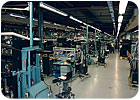
High-Mix Production
Manufacturing operations at IBM Poughkeepsie include a diverse set of processes, ranging from high-volume, repetitive, plug-and-placement panel assembly to moderately complex build-to-plan nodes to lower volume, highly complex build-to-order fulfillment cells. Those one-of-a-kind build configurations are engineered and manufactured to very demanding specifications-all products assembled in the plant have a mean-time-to-fail measurement that could potentially reach 50 years.“We have a labor-intensive process that depends on highly skilled knowledge workers to assemble and configure these product lines,” says King. “Our processes are well-defined and followed with a great deal of precision to recognize successful performance against key process indicators which the company and our customers rely on. What makes this plant unique is that we have both a build-to-plan fabrication process as well as a build-to-order fulfillment process.”
The build-to-plan model is used for repetitive assembly processes and high-usage subassemblies, while the build-to-order model applies to complex subassemblies that are configured to a particular customer request. Orders consist not only of hardware and feature offerings, but also software preload options. As a result, all features offered on both System z and Power Systems are customizable to the point of having an almost infinite combination of configuration possibilities.
“The hardware is manufactured and tested to strict specifications, and is extremely dependent on feature topology, placement, connection and parametric performance criteria,” says Boldrin. “Our business model also provides for field upgrades to occur on any given machine type or serial number in the field. This forces us to test full configurations in the factory, prior to shipping to the customer.”
In the early years of high-end server manufacturing at IBM, each order was built from scratch for each independent customer. Component, fab subassembly and system configuration testing was done in a serial manner only after the entire entity was assembled. This resulted in a much longer test process, and consequently, the lead time to delivery was often six to eight weeks.
“Today, with the fab fulfillment process, we’ve recognized many efficiency gains where we test components and subassemblies far in advance of the eventual allocation and consumption into a configured entity tied to a customer order,” Boldrin points out. “This significantly reduces the lead time from what was months to what is now typically less than five days.
“This has resulted in many inherent benefits from a manufacturing perspective,” adds Boldrin. “For instance, fewer people are required to manufacture the product; less inventory is needed; and there has been a reduction in the number of parts required to assemble a high-end server. In addition, there is much less space required to support the manufacturing processes.”
The Poughkeepsie fulfillment processes can achieve turnaround times that rival much less complex products, such as low-end servers, storage devices and laptop computers. The plant closely monitors customer demands to ensure that the appropriate level of work-in-process is prebuilt and stocked in a kanban system in support of anticipated fulfillment demand.
“This emphasis on speed has significantly reduced the time required to fulfill an order, allowing the manufacturing team to satisfy a high-end server order within 48 hours from customer order entry to shipment,” says King. “That includes assembly, testing, packaging and putting the order on a truck.” Customers can also order upgrades to their existing servers, which can be assembled and shipped within a few hours.
Because of the complexity of the products, the manufacturing environment at the Poughkeepsie plant is considered relatively low-volume, as compared to desktop or laptop hardware. Power System and System z products are produced on the same assemble line, which consists of mobile workstations.
Once a customer order is received, the prefabricated parts are used to assemble the order. Sheet metal chassis, frames, racks and doors are built by outside vendors. Most inventory is owned by suppliers until it’s pulled for use on the plant floor.
The central processing unit, which is referred to as a “book,” is assembled and tested in environmentally controlled rooms at the plant to prevent damage. Assemblers install multichip modules onto boards and incorporate the boards into higher level assemblies known as processing unit books or nodes. Kitting is used to reduce cycle times and reduce wasted motion.
Assemblers wear ESD straps and refer to electronic work instructions on laptop computers attached to mobile workstations. Every set of instructions is unique to the customer order and specific requirements.
Each computer is assembled by one operator who is responsible for installing all subassemblies and components, such as input-output drawer and nodes, which are slid into racks and networked together. In addition, they install the power unit and attach all cables, wiring harnesses and controls.
Fasteners are attached with DC electric tools that are equipped with bar-code scanners. That allows IBM to trace serial numbers on parts. “Given the quality implications, as well as high dollar value of parts, we have extensive serialization practices,” says Edge. “A fundamental requirement is that we have visibility to the genealogy of a component (child) upward to the subassemblies (parents) and eventually into the entity that gets shipped to the field. This also includes the placement of this serial number to the slot level.”
Operators use a wide variety of lifting devices and material handling equipment because the subassemblies are heavy. For instance, each node that is inserted into a machine weighs 120 pounds; each machine can hold up to eight nodes. When fully assembled, a high-end server typically weighs more than 3,000 pounds.
After each machine is assembled, it’s run through an extensive test cycle to ensure IBM’s legendary reliability. A team of technicians exposes the computer to a 24-hour test that simulates both hot and cold operating conditions.
Typically, a large number of orders flow into the factory toward the end of each quarter and toward the end of each year. That demand bubble occurs because high-end servers tend to be a major capital expenditure for most of IBM’s customers. Often, funds don’t become allocated or approved until quarterly financial performance results are tallied up.
The hybrid fabrication and fulfillment model allows the plant to optimize resources to perform build-to-plan processes earlier in the quarter, then subsequently shift the available capacity over to support build-to-order operations based on shifts in demand. The assembly workcells and test cells can accommodate either System z or Power Systems products, thus allowing maximum flexibility for responding to the marketplace.
Another high-mix, low-volume challenge faced by assemblers is that orders can be altered at any point in the build cycle. About 20 percent to 30 percent of all orders change late in the assembly cycle. In fact, customers can make alterations right up until the time their computer is shipped. “Our systems and processes are designed so that we can preserve the manufacturing value in the process and respond only to the net-change of the functional alteration,” claims King.
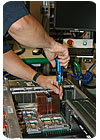
Home-Spun Lean Initiative
To live up to IBM’s famous reputation for innovation, the 2008 Assembly Plant of the Year uses a home-grown version of lean manufacturing that it calls Path Forward. The initiative was started three years ago by an advanced manufacturing sciences (AMS) team that is made up of operators, manufacturing engineers and supply chain specialists.“The project encourages cultural transformation, which stresses growing technical skills in the manufacturing space, while also positively impacting morale and ownership of the processes,” says Chris Foltz, materials, logistics and hardware support manager. “We pull operators off the plant floor, put them in a classroom environment, and teach the basic principles of lean manufacturing.”
All production processes within the plant are executed and measured against precise goals and objectives to drive continuous improvement. These include managing inventory levels, quality measurements, and on-time delivery metrics, all of which are closely aligned to various fiscal measurements. “We employ leading-edge philosophies to increase our inventory turns through embracing supplier collaboration and pursuing various vendor-managed inventory practices,” Foltz points out.
The AMS team recently completed a comprehensive 5S program across a large portion of the Poughkeepsie plant floor. “Roughly 50 percent of our manufacturing space has been modified either through repositioning or infrastructure upgrades in the last 12 months,” says Foltz. “These enhancements were made while still preserving business continuity and maintaining 100 percent on-time shipments, as well as exceeding quality level targets.
“Throughout this work, we’ve extensively used a simulation tool to facilitate change through more intelligent, data-driven decision making,” adds Foltz. “It gives us a ‘sandbox’ to play in before making any process changes.”
The new and improved plant layout has resulted in dramatically smaller circles of motion and smoother production flow. Other benefits include significantly lower cycle times and a reduction in time to market, as well as a reduction in manufacturing costs. The AMS team has even applied for several U.S. patents because of the novel supply chain concepts that were used as part of the project.
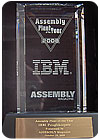
About the Award
The ASSEMBLY magazine Assembly Plant of the Year award was initiated in 2004 to showcase world-class production facilities in America, and the people, products and processes that make them successful. All manufacturers that assemble products in the United States are invited to nominate their plants.
The goal of the award is to identify a state-of-the-art facility that has applied world-class processes to reduce production cost, increase productivity, shorten time to market or improve product quality.
An official nomination form was printed in several issues of ASSEMBLY earlier this year; in addition, an online version appeared on the magazine’s Web site. Nominations were received from a diverse group of manufacturers that reflect the magazine’s demographics.
All nominees were evaluated by a group of independent experts and by ASSEMBLY’s editorial staff, based on the following criteria:
- Have assembly processes been improved through the use of new technology?
- Has the plant improved its performance by making more effective use of existing technology?
- Has the plant taken steps to reduce production costs?
- Have new or improved assembly processes resulted in increased productivity?
- Has the plant used assembly improvements to reduce time to market?
- Has the plant boosted bottom-line profits and competitive advantage?
- Has a product been effectively designed for efficient assembly?
- Has the plant attempted to protect the environment and conserve natural resources?
As winner of the fifth annual Assembly Plant of the Year competition, the IBM High-End Server Plant (Poughkeepsie, NY) received an engraved crystal award and a commemorative banner during a special presentation at the plant.
Previous recipients of the Assembly Plant of the Year award were Schneider Electric/Square D (Lexington, KY); Lear Corp. (Montgomery, AL); Xerox Corp. (Webster, NY); and Kenworth Truck Co. (Renton, WA). Nomination forms for the 2009 Assembly Plant of the Year award will be available early next year at www.assemblymag.com.
To learn more about the IBM Poughkeepsie plant, search for these article on ASSEMBLY’s Web site:
- A Helping Hand in the Community.
- Green Sigma Initiative.
- Historic Neighborhood.
- Innovative THINKing.
- The Smart People Behind the Smart Products.
- World-Class Supply Chain.
